|
|
|
DISKUS Vol. 10 (2009)
http://www.basr.ac.uk/diskus/diskus10/jaschok.htm
Chinese Hui Muslim Women At Home:
tradition, dignity and modernization in a global context
Maria Jaschok
Department of International Development
University of Oxford
Queen Elizabeth House
3 Mansfield Road
Oxford OX1 3TB
Oxford OX
E-mail: maria.jaschok@qeh.ox.ac.uk
Abstract
Not
all traditions have value and some are contrary to human rights and must be
combated. One must distinguish between necessary tolerance and blindness to
degrading treatments and violations of human rights. For freedom of religion
not to be contrary to women’s rights the right to difference inherent in the
former must not become a right to indifference to the condition of women.
What is ‘home’ to Chinese Hui
Muslim women in a globalizing world into which China has emerged as an economic
and political superpower, a major player in multilateral organizations and in
exclusive gatherings of major global economic actors? Indeed, how is the
‘global’ imagined and negotiated in the local communities of ethno-religious
minority groups which constitute the Muslim population in
China
? [2] If
globalization, as R. Robertson defines it, are ‘both the compression of the
world and the intensification of consciousness of the world as a whole’, [3] how
does the spiritual home of Muslim women, the fang [4] of a given women’s mosque, shape the consciousness of their immediate
environments and of ‘the world as a whole?’ It is here, in the identification
with the mosque as defining raison d’être of their communal distinctiveness, and otherness, that continuities of Islamic
faith and Muslim traditions are made, and remade. In the words of Kim Knott, ‘…
people construct such sites or environments through their imaginations,
memories, actions, and speech’ [5] –
as simultaneously the changing world around them presses on them with the full
weight of patriarchal disapproval and State engendered secular development
ideology. But the presence of women’s
traditional places of worship and education makes all the difference to Muslim
women whose pride in their centuries-old tradition engenders dignity and,
because of legitimately occupied social space, historical and legal rights. These
sites may be heavily contested but have also allowed for resistance to arise, if
subtle or concealed. Moreover, in recent years voices have emerged which are
adding to secular mainstream discourses over the nature and future of societal
developments the previously unheard perspectives of religious believers.
The Establishment of the
Beijing Niujie (
Ox Street
)
Women’s Mosque
Let me begin with the story of a
women’s mosque in the heart of China’s capital Beijing, in what was once the
flourishing Lao Huiqu (Old Muslim Quarter)
where settled for hundreds of years China’s most populous Muslims, the Hui
Muslims. This former lively quarter of old courtyard residences, halal meat
butchers, jewellery and pawn shops, sweet-stalls and eating houses, not to
forget numerous mosques, was flattened by the tidal wave of commercial
re-development. Nowadays, souvenir-shops, restaurants, modern high-rise
apartment buildings, the Beijing Islamic College (State-controlled) and, of
course, the Niujie Da Libaisi, the Ox
Street Old Mosque, both a site of worship and ablution (watched over by the
mosque branch of the China Islamic Association) and a Chinese government assembled
window-display to the world, attracts local and international tourists as well
as visitors from Muslim countries, in particular from the Middle East.
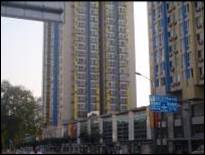 In place of the old: the redeveloped
Hui Quarter, Beijing [6]
Something new has recently been
added beyond the Ox Street Mosque, referred to by local Muslim women as the ‘men’s
mosque.’ [7] A
women’s mosque has been built, separated from the men’s mosque by a narrow
lane, connected by a series of side-doors which enable believers to go from one
to the other. The side gate carries the new inscription Nü libaisi (women’s mosque), using the same term as is used to
refer to the (men’s) Niujie libaisi (Ox
Street Mosque). In place of the old: the redeveloped
Hui Quarter, Beijing [6]
Something new has recently been
added beyond the Ox Street Mosque, referred to by local Muslim women as the ‘men’s
mosque.’ [7] A
women’s mosque has been built, separated from the men’s mosque by a narrow
lane, connected by a series of side-doors which enable believers to go from one
to the other. The side gate carries the new inscription Nü libaisi (women’s mosque), using the same term as is used to
refer to the (men’s) Niujie libaisi (Ox
Street Mosque).
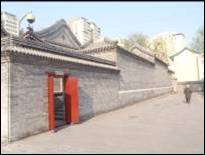 New women’s mosque (2007) Niujie (
Ox Street
), side
gate
This new women’s mosque is built on
a large scale, beautifully roofed, tiled, ornamented, carved and furnished; it
looks like a traditional Confucian lineage hall (as do most mosques in certain
parts of China). It comprises a
reception room, ablution rooms, classrooms and the large prayer hall where a
woman shifu (caretaker) watches for
violations of proper Islamic conduct. And she is not shy to reprimand in stern
tones! The wall which frames the main gate features the inscription which once identified
the old women’s mosque in
Shouliu
Lane
, using the generic term for [women’s] mosque, Nü Qingzhensi. Closed down in 1958, it
was never reopened – unlike the men’s mosque nearby. The former women’s mosque
served first as a factory, then as a kindergarten. New women’s mosque (2007) Niujie (
Ox Street
), side
gate
This new women’s mosque is built on
a large scale, beautifully roofed, tiled, ornamented, carved and furnished; it
looks like a traditional Confucian lineage hall (as do most mosques in certain
parts of China). It comprises a
reception room, ablution rooms, classrooms and the large prayer hall where a
woman shifu (caretaker) watches for
violations of proper Islamic conduct. And she is not shy to reprimand in stern
tones! The wall which frames the main gate features the inscription which once identified
the old women’s mosque in
Shouliu
Lane
, using the generic term for [women’s] mosque, Nü Qingzhensi. Closed down in 1958, it
was never reopened – unlike the men’s mosque nearby. The former women’s mosque
served first as a factory, then as a kindergarten.
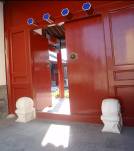 Main-gate of new
Beijing
women’s mosque, leading into inner
courtyard Main-gate of new
Beijing
women’s mosque, leading into inner
courtyard
The considerable cost of this project
was underwritten by the City government authorities with some support from the local
Muslim community. On the other hand, initiative for this mosque came in large part
from local female believers who for many patient years had petitioned the China
Islamic Association, the male leadership of the Ox Street Mosque and even the All-China
Women’s Federation to restore to them their historical right to a women-only
site of prayer, congregation, education, and counsel – led by their own female ahong. In response, local Muslim women
were exhorted to pray at home. Those who insisted on performing rites of ablution
and prayer outside the home were directed to the backroom of the
Ox Street
(men’s)
Mosque where a small room and a rather cramped ablution room were available for
their use. No woman ahong was
present. Indeed, for many years, each time I visited, I asked the same question
(the question asked by local Muslim women), and I was informed that, first of
all, a women’s mosque was bound to be build, quite, quite soon, and, second, that
the conditions under which the Muslim diaspora in China had produced women’s
mosques in central China (where they were, and are, present in the greatest numbers)
and to a lesser extent elsewhere in the country, no longer obtained. Although historically,
it was then argued, such innovation may have been a necessity, even a hao bidaerti (a laudable innovation
which educated women, thus family and society, at a time when the Islamic faith
and Muslim identity were in crisis), recent re-connection of Chinese
Muslims with the ‘true faith’ of their forefathers, I was informed, meant that
such practice was now seen as huai
bidaerti (aberration from Islamic orthopraxy) and best put to rest. Given
such resistance in
Beijing
’s
Muslim community, what happened to allow for the construction, on such a grand
scale, of an Islamic site of worship for the exclusive use of women? What does
this mosque tell us about the relations of the
Chinese
State
,
popularly perceived as hostile to religious practices, with its Muslim
population? What does it tell us about State management of a policy of peaceful
co-existence of ethnic and religious minorities on which the Party-State prides
itself on? How does gender politics come into this complex interplay of
religion, politics and development discourses?
Global Islam, but also
Chinese
State
policies towards its minorities
and specifically toward minority women, has shaped Muslim women’s opportunities
for negotiating a widening of collective aspirations. Changing conceptions and
growing realizations of the strength of their voices in local public life, whilst
influenced by wider forces, are at the same time nourished by reconnection with
their own indigenous traditions, and a growing pride in the uniqueness of their
achievements as both Muslim women and as Chinese Muslims.
In many ways the history of the
Beijing
women’s mosque might
be seen as emblematic of religious women’s strength and vulnerability. The ‘hidden
transcripts’ of many years of silenced
religious practice have been locked more deeply into concealment as the State
demonstrates the reach of its power in a display of opulence. An Islamic place
of worship serves to masque the reality of power as it shows its liberal
treatment of religious minorities and, moreover, of advocacy of women’s rights
in the sphere of Islam. Where elsewhere Islam might be associated with
repression of women, the women’s mosque in the heart of the Chinese capital
tells us, in China Muslim women are at least assured of the legal entitlements
open to all Chinese women. It might also
be argued that the forces of political Islam are given the message that the State
will not tolerate subversion in any form, including that which applies to the (foreign-influenced)
impact of Islamic law on any aspect of social and gender life. Simultaneously,
the highly visible State-approved site for women’s religious worship signals an
effective response to criticism from the ‘West’ over
China
’s record on human, religious
or women’s rights.
‘Religious experience in global contexts’
________________________________________________________________
In this depiction of a single
religious site, a newly-built women’s mosque subsidized by an assertively
secularist Communist Party-State, preparing to welcome ‘the world’, including
Muslim world, for the Olympic Games in 2008, and in the face of at best
luke-warm support from China’s Islamic patriarchy, I am drawing on a number of
themes and issues arising from the intersections of competing claims to women’s
affinity and belonging. The core questions concern inter-connectedness of Muslim
diaspora communities with the ‘homeland’,
Mecca
as part of the highly politicized region of the Middle East (which for Muslim
women in
China
represents the West). Furthermore, with the opening of China to multilateral
world systems, the intensification of competition between rival meaning systems
for ‘hearts and minds’ of target populations through development projects and
local investments have confronted female-led institutions with uncertainty over
their future role in society, even over their very survival, but has also
granted opportunities for voicing claims to rightful identities.
Together with the sociologist Shui
Jingjun, who comes from a Hui Muslim family in central
China
, I have since 1994 conducted research into
the genesis and evolution of Islamic female-led institutions in
China
, using ethnographic
research and oral history in an area where written sources are scarce. We discovered the historical challenge to Islamic patriarchy by female
believers which has become institutionalized into complementary, but sometimes also
oppositional, practises and traditions. We did not uncover theological debates and
challenges nor the ‘double readings’ involving the sort of paradigm shifts
through which women and gender studies elsewhere prodded and provoked
mainstream scholarship – ‘shaking of foundations, a radical remapping of our
intellectual and academic landscape, and a repositioning of bodies of knowledge
that relate to religion,’ to quote from Ursula King’s observations on the
impact of feminism on the study of, and practices in, world religions. Little trace of women’s imprint may be found in texts whether in mainstream or
marginal discourses on Islam in
China
. Instead, it is at the local level that we uncovered evidence of how women
religious leaders and ordinary believers have en-gendered readings, sermons,
assemblies, places, events and rituals to express aspiration and to respond to
changing needs, for the benefit their families and communities. Merry
Wiesner-Hanks says, ‘Religions provide myths, symbols, and narratives that
express desires for transcendence, redemption, salvation, liberation, and
wholeness, but that also enforce inequalities, oppression, separation, and
hierarchies. The relations between
profoundly transformative and deeply conservative aspects of any religion play
themselves out at the local level, but often with references to values that are perceived as
unchanging and divinely ordained.’ Tensions
between ‘transformative’ and ‘changing’ aspects of Islam have sharpened over
the years as local communities of believers came under pressure to align
themselves with aggressive secularist development policies of the Chinese
Communist Party when simultaneously other sources of development were becoming
available, importantly also from the Middle East.
The impact of competing religious
and secular transnational development organizations on local identity is not
sufficiently understood the anthropologist Bertram Turner says. According
to Turner, the competition between certain development organizations which put
forward ‘ideals of the western way of life’ (notions such as development,
democratization, good governance, sustainability, and so on), on the one hand,
and on the other hand, transnationally active Islamic movements advocating
development based on return to Islamic roots, needs looking at more closely.
His argument is that such ever intensifying competition for local development can have positive consequences for local
communities such as we research (whether in
Gansu
,
in Xinjiang or in
Henan
).
Such competition, he maintains, grants local communities choice by giving them
alternative models of development which they can accept as appropriate or
reject. It has made for the phenomenon of ‘empowered legal agency’ (Turner) of
local Muslim communities as rival funding organizations compete for their allegiances
through funding assistance.
Consider the nature of such
approach in connection with an international research consortium in which I am
currently participating through my research in
China
’s Muslim communities. The
title of the research consortium’s project, ‘Women’s Empowerment in Muslim
Contexts. Gender, Poverty and Democratisation from the Inside Out’ (WEMC) suggests the complexity, let alone sensitivity, of issues we raising over
competing value and meaning systems in which such concepts as ‘Empowerment’,
‘Gender’, Democracy’ and the implicit concept here of exercise of and control
over individual (women’s) agency have specific and embedded significance. Both
religious (Islam) and secular development aid are global forces which
contribute to the shaping of this complex international society in which States
and non-State actors compete for allegiance. Their relationship and respective
origins suggest dichotomy of interest, values and objectives. Religious ideals
versus secular policy programmes, afterlife versus this-worldly concerns;
recuperation of asala (blueprint of
Islamic life) versus unilinearity of material progress; scriptural sources
versus development manuals and millennium development goals (MDGs). But that there
are no simple binaries of either/or approaches is shown in the growing number
of research projects, conferences and publications which are addressing the
widening participation of religions organizations in development work – engaged
in a broad spectrum of work ranging from HIV/AIDS to street children to
domestic violence. Indeed,
religious and secular organizations are intimately intertwined. It can be
argued as Bertram Turner has done (the anthropologist just cited) that current
development work with its global institutional outreach in all spheres of
political, social and economic as well as cultural life has many colonial
resonances and that both the missionary incursions into the ‘pagan world’ and
the ‘development agency interventions’ in the ‘developing world’ share assumptions
and values of certainties derived from moral and/or technological superiority
of the ‘western’ world.
‘Raising the
calibre of [Muslim] women'
Religious
values may be seen to provide alternative notions and directions of development
and progress in a given society, challenging more established views on meanings
and purpose of social change. The anthropologist Carol Delaney asks:
Where do we
situate the motive forces of change, as well as the forces of resistance not
only against the dominant system but also against the forces of change? We must
ask whether an approach to the study of human culture that is grounded on
universalistic premises about work, the division of labor, and the
transformation of society is appropriate for all cultures, including Muslim
cultures. In Islam the focus of attention is not on the transformation of society but on its recuperation. History does
not refer to “the ever changing creation of new meanings of human life but to
the struggle to recapture and immobilize an eternal experience.”
In the Turkish Sunni Muslim
villages studied by Delaney, she say, ‘Islam penetrates daily life as the call
to prayer five times a day, penetrates one’s being heedless of whether one is a
believer. There is no escape; it is the very context in which daily life
unfolds.’ In
China
, the
great diversity of Muslim women’s lives reflects the diversity of the overall
Chinese Muslim population. The relatively closed Sunni Muslim communities which
reside in the border areas of northwest
China
,
among them Dongxiang and Bao’an Muslim communities in the southern part of
Gansu
Province
,
are not unlike the Turkish villages described by Delaney. In these Muslim
milieus, whether adhering to the gedimu or yihewani traditions, both locally embedded strands of Sunni
Islam, the latter more recent and a more austere practice of Islam, the Muslim
family is central to all social life; it is the miniature of the whole of
Muslim society. The father’s authority is
symbolic of the authority of God. The daughter’s relation with the father, the
wife’s relation with the husband and father of her children, all express a
deeply internalized notion of the proper Muslim value, Muslim conduct, Muslim
ethics and responsibility, and the proper Muslim gender.
Anthropologists like Delaney have
identified the symbolic world around ideas of procreation and the overlapping
of divine and worldly order, and women’s and men’s roles in this procreative
scheme, as central to Islamic society, and to how social and gender relations
and distribution of power and authority are organized. The decisive role in
conception attributed to males and the more passive and nurturing role
attributed to women are mirrored in social and kinship arrangements in the
Muslim communities we study. As the feminine is excluded at the level of the
divine, the exclusion becomes attached to women, who are disassociated from
power and from participation in public life – as clearly visible in Dongxiang
and Baoan communities. This poses challenges to those of us who arrive in these
communities with missions such as outlined earlier as the defining mission of
the international research programme in which I am participating.
On the other hand, cautiously
critical voices have emerged from among the Hui (Sunni) Islamic communities we
study in central
China
.
Different from Muslim counties and townships in the borderland regions of
northwest
China
,
patterns of settlements in inland provinces are characterized by a wider
dispersal, with Muslims living in close neighbourhood with non-Muslims, and
their lives frequently indistinguishable from their Han Chinese neighbours. It
is here that voices have emerged asserting Muslim identity and positionality. Although
still relatively rare, intellectuals are taking part in public discourse, claiming
allegiance neither to the mainstream notion of secular development, advocated
by the Party/State, nor to a traditionalist Islamic position on gender
relations and the role of women. My Chinese colleague Shui Jingjun, herself a member
of the Hui nationality and a practising Muslim, presented at a recent workshop a brief concept paper in
which she sought to clarify her understanding of ‘development’ and
offered a Chinese Hui Muslim understanding of development. And she drew upon a
context of tidal waves of development discourse, to cite her words, which has
borne down on Chinese women in general, and Muslim women in particular, since
the 1990s, on which are riding the Chinese Party-State government, the
All-China Women’s Federation (a mass women’s organization implementing official
policies), international and national NGOs, and local philanthropic
institutions. These all contribute, in
her estimation, to a hegemonic secularist development discourse on ‘raising the
calibre of [minority] women’ (tigao
[shaoshu minzu] funüde suzhi), raising to a standard, ‘naturally set by
mainstream [i.e. non-religious] women’ --- whereas other voices are missing.
True respect for the history, culture and aspirations of Muslim women, she
says, imagines notions of betterment and progress around what is considered by
women from a different religious culture as appropriate and desirable (e.g.,
improving services of women’s own institutions, such as nüsi/xue), instead of superimposing oppressive (secular) mainstream
indicators of development (often, she says, with the help of Western NGOs).
When researchers in the afore-mentioned
WEMC project came together, in the second year of our work, to discuss
methodologies applied in ‘the field’ to facilitate women’s ‘coming to voice’,
tensions arose over identification of ‘authentic’ voice on the part of local
women, over translatability of core concepts of empowerment across cultures and
belief systems! The index of progress as successful preservation of their own
historical traditions, on the part of Chinese Muslim partners, came to be challenged
by indices of progress, advocated by colleagues from a background of
transnational feminist activism, which were predicated on the successful
dismantling of all ‘tradition’ in particular those rooted in religion. On the
one hand, a local perspective sought to protect the cultural and material
heritage of their own, unique participation in Chinese Muslim history, the
institution of women’s mosques, and invested these with renewed pride in their
achievement. On the other hand, the perspective brought to bear on the debate
by activists well versed in confronting political Islam’s gender rhetoric,
treated women’s mosques as sites of ‘traditionalism’, as confining women’s
horizon and imagination to a past-orientation that could only be obstructive to
development strategies. In a failure of the imagination, the women considered
‘backward’ were not accorded the dignity of getting a hearing. It was therefore
only too easy to dismiss their narratives with references to ‘provincialized’
subjectivities, in other words, women who had become too deeply habituated to
gender inequality as to notice its impact on their very ability to will change.
These
tensions are rooted in current transnational debates between those who call to
uphold the universality of women’s rights and those who maintain that there is
greater need for respect for context-sensitive women’s rights. Thus the NGO
Committee on Freedom of Belief pronounced in 2002 that ‘Women’s rights are
incontestably part of fundamental and universal human rights and are inherent
to human dignity. Cultural and religious specificities must give way if there
is prejudice to women’s dignity. Dignity is the common denominator for all
peoples.’ Distinguishing between the
‘universality’ of human and women’s rights and norms and values which reflect local
cultural and social constellations, the Committee points to the important role
played by religions to ‘restore the reforming role of religions against
patriarchal domination.’ While
culture, freedom of religion or belief --- the fortresses of collective rights
--- are held to be important but also ultimately relative, ‘respect for life,
human dignity, non-discrimination and women’s rights are invariants which can
serve to unite humanity.’
Yet the means by which women aspire
to, and, sometimes acquire, ‘universal’ rights can only be understood in terms
of their most immediate, local conditions and circumstances. However, when we
are as researchers exhorted to interrogate the ‘real’ experiences of women,
access to their stories is all too often guarded by immovable gate-keepers, may
they represent the State or authoritative socio-cultural institutions. Shirley
and Edwin Ardener introduced the concept of ‘muted groups’ to theorize dominant
male systems of perceptions and women’s under-representation in symbolic,
cultural and socio-political domains, moreover co-opted into, often themselves upholding,
the structures of power that confine them. Whether
in pure academic or applied and development-focuses research, the challenge is
to hear from among the caconophy of voices in the public sphere, where
researchers move, the muted voices of Muslim women in northwest China. In order
to understand the cultural bind of women it is necessary to consider the
seemingly paradoxical State policy in relation to the ‘protection’ of ‘the
minority way-of-life.’ State policy on the treatment of minority populations in
China
’s
borderland areas has led to the submergence of the rights of its most vulnerable
members, women, into the collective identity, and interests, of their group.
State
management of ethno-religious minorities / Islam in
China
Map of
China
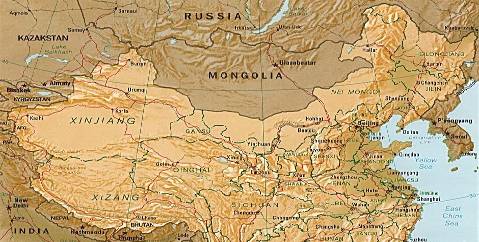
The relevant Chinese political
contexts which most forcefully translate the forces of globalization, are,
firstly, the growing identification of many Chinese Muslims with a politicised application of ‘Islam’ and the
concomitant shift of other identities, including local and national identities.
The response of the
Chinese
State
to these developments
then carries implications for human rights’ movements and for women’s and
social justice movements. Women’s bargaining to further their interests takes
place in the interstices between collectivity and the State, an ever cautious
manoeuvring through unpredictable political waters which however has reaped
extraordinary benefits - for certain communities of active Muslim women
believers.
The diversity of
China
’s widely
scattered Muslim population is informed by geography, ethnicity, cultural and
material environments and by the geo-political importance of given communities
to the Party/State. Aihwa Ong,
in her study of spatiality of sovereignty under the inroad of market ideology,
has developed a helpful model of technology of government as a ‘neoliberal’
model. Strong East Asian States engage in what she calls ‘strategic and
situational exercise of power that respond to crises and challenges by invoking
exceptions to political normativity.’ The
emergency in the socialist system of production is being countered by carving
up spaces (i.e., Special Economic Zones) and introducing conditions (i.e.,
special taxation, investment schemes, labour conditions) as calculated policies
of ‘exception’. Such policies of ‘exceptions’ preserve certain benefits for
citizens even under global market pressures from which non-citizens, and
vulnerable groups, although indispensable to growth, continue to be excluded. Such
zoning strategies, I would argue, have been equally applicable to State rule
over ethnic borderland areas. Central rule was bolstered through administrative
self-governing or autonomous district and provincial governments, with policies
of ‘exception’ crisscrossing communities with a web of laws, policies, rules,
decrees which grant circumscribed independence
of finance, independence of economic planning, independence of arts, science
and culture, organization of local police, and use of local language.
What however in principle should have
served as a sound legal and political foundation for the preservation of
ethnic, cultural, and religious integrity of minority populations in China is
compromised by a combination of ineffectual policy approaches by a remote State
and by uneven policy implementation at local and meso level, complicated
further by top-down approaches to governance and lack of consultation with
local communities. Mostly found in western and northwest regions, their
minority populations appear in statistics of enduring poverty fragmenting the
body politic into unequal sections, marked by economic, social, cultural and
technological disparities. But the marginalization of communities, in
particularly the borderland regions of western and northwestern
China
,
of modes of existence eked out as ‘bare life’ (Ong), are no longer, as it once
was the case, hidden from view. New multilateral systems of interventions, such
as religious organizations and NGOs, local communities and corporations, are
contributing to the emergence into view, and into the international conscience,
of marginal peoples as ‘morally deserving humanity.’
‘Situated NGO
interventions are often determined by the nexus of political and ethical forces
they encounter on the ground. In short, the counterpolitics of survival are
crystallized through the interrelationships of biopolitics, labor markets, and
systems of virtue. Such ethical problematization may circumvent human rights or
citizenship, coming to rest on resolutions that reflect contingent and
ambiguous ethical horizons of the human.’
At the same time, as zones of
international NGO and development agencies have opened up ‘marginal’ China (as
in the provinces of Yunnan, Guizhou, Ningxia, Gansu), China is also
accelerating efforts to strengthen its official development institutions and
policies and its indigenous philanthropy, both secular and religious, all these
making a strong comeback in Chinese society. Intervention on the part of
international organizations and agencies, whether social justice or development
orientated, is seen with disfavour and subjected to closest surveillance by
officials. There is a pervasive fear among Chinese officials and academics that
Western government-sponsored development projects aim to ‘democratize China and
make China a country which no longer has its own culture, politics and economy’
(private conversation in Gansu, September 2006). The outcome of this palpable
tension engendered by the Chinese Party State’s difficult balancing act of
retaining political control through selective surrendering of control (whether
in zones of capitalist profit maximisation or in zones of humanitarian
intervention) is an atmosphere of uncertainty and anxiety among those who try
to address social and gender injustice in local Muslim communities.
Despite extensive legal, policy,
institutional resources relating to women’s rights and interests, central
government policies of exception related to ethnically defined autonomous
regions in
Gansu
Province
continue to allow for
situations to be observed in the communities we study where women are excluded
from the public sphere of political rights and claims to societal resources. From a gender perspective, where the interest
of the (male-dominated) community is balanced with rights of women, and they do
not always overlap, women lose out. It is the mantra of old, xian guojia, hou funü (first country,
then women). Of course, this is
complicated by various allegiances and loyalties.
The growing influence of a more austere
Islam in bringing forth in certain areas a strengthened masculinisation of the
public sphere (accompanied by women’s economic withdrawal to the home, as in central
China
’s
Henan
Province
;
absence of institutions and organizations representing the interests of women,
as in Dongxiang and in Baoan communities) forms part of our investigation.
Where elsewhere Muslim women activists, particularly so in southeast Asia, call for State intervention to curb the power of Muslim clerics, relations of
Muslim women in China with religious and State authority are circumscribed by history
(the collective memory of all Muslims of oppression and outright persecution
throughout the history of Islam in China) and by communal solidarity as members
of besieged communities (in particular in western and northwest regions where
they live in greater concentration), a situation which complicates representation
of issues specific to women.
Asma Jahangir, the Special UN Rapporteur on the implementation of
the 1981 Declaration on the Elimination of All Forms of Intolerance and
Discrimination Based on Religion or Belief, asks for effective implementation of existing national laws and
international human rights standards with governments playing a critical role
in ensuring protection of women.
As many women suffer from aggravated discrimination
with regard to their religious, ethnic and sexual identities, national and
international action is required to prevent such aggravated discrimination and
to improve the protective efforts. Prevention requires first of all identifying cultural practices that are
harmful for women and girls; States should then prepare strategies, e.g.
through educative, legislative and health-related measures, in order to
eliminate prejudicial practices especially where they are deeply rooted in
society.
In response to critical questions over why such discrimination was
enduring in the light of considerable action at both international and national
level, researchers taking part in the Women in Muslim Context project hold that women ’s rights of full participation in private and public spheres are ‘in
crisis because political Islamists claim that religion itself sanctions women’s
disempowerment. ’However … ‘[the] use of culture and religion to deny women’s
rights’ is neither confined to Islamists nor to Muslim contexts, … [but is]
equally relevant to ‘non-Muslim contexts with other disempowering
politico-religious constructions.’ Insights
from research in
Pakistan
,
Indonesia
,
Iran
and from Muslim contexts in
China
have shown how policies unavoidably filter through meso-level decision-making
before reaching women. The purview
afforded at the meso level is one of ‘localised power within partial
territories of the State, such as provinces, districts, villages, households’
where women’s lives are shaped, beyond, often even separate from the
macro-powers of the State wherever States exercise diminished control, have
abrogated their powers or govern by indirect rule through institutions, Naila
Kabeer points out, that ‘help structure the distribution of resources and
activities at micro-level.’ Power structures and power dynamics located
at the meso level, where religious institutional authority is frequently
located, can operate autonomously of the State at the macro level. Tensions
between opposing forces, whether between State and locally embedded political
Islamists or between rival Islamic parties, are invariably gendered, fetishizing
the ‘Muslim woman’ as ‘the cornerstone of an equally constructed, supposedly
“Muslim world”’. The
site of disempowerment for women is ‘on the ground.’ In the language of Aihwa
Ong, ‘this milieu is a space of betwixt and between that is the site of the
problem and of its resolution.’ It
is in such a space that Chinese Muslim women most closely experience the
combined force of State and religious authority; in such a space are located
women’s mosques, confined by government laws and bylaws, configured by Islamic
doctrinal pronouncements.
But even in the apparently most repressive
conditions, there exists the possibility of challenge. In the words of Anthony
Giddens, ‘all forms of dependence offer some resources whereby those who are
subordinate can influence the activities of their superiors’ in the ‘dialectic of control in social systems.’ The
creativity and bargaining power displayed in order to protect and develop their
spiritual home illustrates the resourcefulness of apparently subdued and
passive women.
Women’s mosques – at home during times of
change ________________________________________________________________
Our knowledge of the history of
Islam in
China
,
building on rich Chinese and international scholarship, tells of conflicts and
adjustments, of accommodation and of resistance, of internal purging, schisms
and also of rivalries within Islam. Allès,
Dillon, Boyd Gillette, Gladney and Israeli, among others, have told us of the diversity
of Chinese Muslim life practices, which reflects varied geo-political constellations
and relations with the central State and of changing Chinese Muslim identity as
opening of borders, have also led to strengthening Arabo-centric Muslim
influence. It is in this context
that ‘the Muslim woman’ is becoming boundary subject of Islamic, ethnic and
political identity. Religious education constitutes perhaps the most important battleground
for traditional ideas and progressive reforms. In the these ever more
diversifying sites of secular and public, religious and private education, we
are observing how institutionalisation of competing sources of authority and
power - State, local community, jiao pai (Islamic sects) – mould diverse constructions of Muslim femininity as ‘corner-stone’
of communal identity and as emblematic of the construction of State legitimacy
itself.
Education constitutes both
possibilities, a site of State control and also of subaltern contestation in
the ‘dialectic of control’ (Giddens). Noting the vital struggle of Muslim
feminists worldwide to provide higher education for girls, Aihwa Ong explains
that education in religion is the only way that women will ever undermine the
monopoly of men over the interpretation of Islamic law and Islamic practice.
Ong quotes the Algerian feminist Boutheina Cheriet who observed that ‘at
Beijing
[1995 World
Conference of Women], for the first time, the right to religious higher
education became a demand. That would then give us credibility in interpreting
the texts.’ The institution of
women’s mosques has come out of a tradition of female teaching and learning
with its own corpus of texts and oral tradition of jingge (chants which comprise a rich spectrum of religious and
semi-religious contents, preserving traces of Arabic, Persian and Turkic
languages, and both didactic and serving as eulogy). It is the evolution from
assigned segregated space to a social institution that made possible the
emergence of what Farida Shaheed terms ‘ancestor practices’ –
traditions expressive of women’s subjective feelings and collective practices.
The presence of women’s mosques as
symbolic and cultural symbols of their historical, legitimate place in public
society, form therefore an important thread in documenting women’s collective
capacities to make a difference not only to themselves but also to society
around them. In our research sites in central
China
, a region where these mosques
originated historically over 300 years ago, an important indicator of women’s
individual and collective empowerment is therefore emerging as preservation of tradition. Whereas this
tradition is perceived by local Muslims to have proven its value to female
congregations, they are increasingly obliged to defend their institution. Women
are exposed to attacks of various kinds, as pointed out earlier, whether against
the labelling of its sites as ‘backward’ (juxtaposed to the progress to which
women, unencumbered by religion, lay claim) or indeed against fellow believers at
adjacent (men’s mosques). These are invoking Islamic jurisprudence, that is the
concept of bid’ah, forbidding all innovations as aberration from the true doctrine, to neutralise
competition from women’s mosques for economic resources and income-generation.
More or less open attacks from increasingly Wahabbhi
(fundamentalist)-influenced clerics exacerbate the pressure on female-led
institutions.
How did the presence of women’s own
sacred and social space reinforce, subvert, or alter women’s capacity to access
resources to adjust or remake life as imagined and desired? The sense of safety,
security and spiritual as well as social support women’s mosques provided have
had varied and important consequences for women’s interaction with the local
community but also with the wider world. In a predominantly gender-segregated
society, the learned women teachers, later on ahong, functioned as mediators between the enclosed world of women
and world of public life. Through teaching, counselling, guidance, and more
direct intervention on behalf of ordinary Muslim women, these ahong came arguably to make incursions into public
space, making these ‘safe’ for Muslim daughters, wives and mothers to go to,
thus facilitating their access to educational and cultural as well as religious
resources. They facilitated physical mobility beyond family compounds under the
banner of religious learning and with the families’ support. Apart from
cultivating for women a space of religious learning and worship, strengthening
their place in the Muslim community, they became in the course of time also a
distinct resource to women’s legitimate presence in the public sphere.
1. In the courtyard
of a women’s mosque 2. Listening to the sermon given on zhuma by their ahong
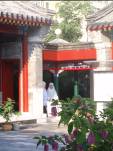 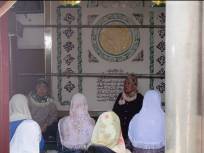 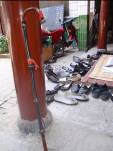 3. During prayer
Many women’s mosques,
in particular those who are guided by capable and respected leaderships, have
come to diversify their services to a grateful community, delivering charity
for families in need, providing education to women and girls (and not
infrequently to non-Muslim girls in rural areas where schooling is poor) and,
in recent times, vocational courses are offered to women unemployed or in need
of additional skills. In this light, religion could be seen as a source of
activity and agency which infuses and facilitates notions of development,
betterment and of relevance to a modernizing society.
Women’s mosque
leaders have these last years not hesitated to critique what they regard as
contamination of the purity of Islamic life by increased commercialisation and
regard to status and income over more religious principles. Some of the most
independent voices among Henan’s female ahong have provided vociferous criticism of corruption in the finances of (often more
affluent) men’s mosques, making themselves the vanguard of a movement calling
for geng ganjing, cleaner, and more
spiritual, life. Arguably therefore, mosque organisation built on institutions
of democratic management committees (in place since 1957 when they were imposed
on mosques by the Communist Party State) and transparent selection procedures
of leaders, that is, ahong, who are
given limited contracts, renewable only after satisfactory performance, have
engendered an accountable, more participatory counter-culture to the opaque
political culture pervasive in Han Chinese society. We have maintained in our
various studies of female Islamic culture that women, more successfully than
men, incorporated organizational structures imposed upon them by the State,
able to turn these into models of ‘collective leadership’ of ahong and
believers in joint charge. One ahong’s
apt description of the symbiotic relationship of ahong, believers and mosque was that of the light of lamp shielded
from volatile winds by the protective shades of the lamp.
Social change
and adapting to modernity must happen as women discover their own place in
history and seek ways to preserve such traditional institutions and conventions
that have effectively proven supportive to women’s aspirations to learn (the
duty of every Muslim is to acquire knowledge), even if learning was often most
rudimentary learning, to worship in line with prescribed prayers and rites, to
translate commands from the Koran and from Hadiths into Muslim family relations
and way of life, and to find important psychological and emotional support in
living as a Muslim, to prepare for houshi (afterlife) in daily tensions between domestic and religious duties. Noa
Nof-Steiner concludes her comparative report on women’s associations in Muslim
countries, urging more attention to be given to women’s rights to associate and
to organize. She says, ‘However, legislative reforms alone do not suffice in transforming
women’s status, unless followed by a shift in social norms and changes in
customs.’ But as our work also
makes clear, those shifts and changes must also come from within, that is, must
come from the aspirations of women themselves.
In discussing
religious experiences I started by asking - whose experiences? It is those with a voice, with a collective voice, with
representation, who may grasp opportunities present in global society – as, for
example, increased bargaining powers of local communities as national and
international development agencies and organizations compete to invest in local
causes. If without voice and representation, any local negotiation with
transnational, frequently Islamic, funding organizations, we can be certain,
will push for agendas which come all too often at the expense of the most
vulnerable members of given communities. Such globalization driven by political
Islamic interests works to the detriment of women’s rights, if no effective
local representation exists, which, as it is happening elsewhere, is shutting women
in as masculinisation of the public sphere proceeds apace. 3. During prayer
Many women’s mosques,
in particular those who are guided by capable and respected leaderships, have
come to diversify their services to a grateful community, delivering charity
for families in need, providing education to women and girls (and not
infrequently to non-Muslim girls in rural areas where schooling is poor) and,
in recent times, vocational courses are offered to women unemployed or in need
of additional skills. In this light, religion could be seen as a source of
activity and agency which infuses and facilitates notions of development,
betterment and of relevance to a modernizing society.
Women’s mosque
leaders have these last years not hesitated to critique what they regard as
contamination of the purity of Islamic life by increased commercialisation and
regard to status and income over more religious principles. Some of the most
independent voices among Henan’s female ahong have provided vociferous criticism of corruption in the finances of (often more
affluent) men’s mosques, making themselves the vanguard of a movement calling
for geng ganjing, cleaner, and more
spiritual, life. Arguably therefore, mosque organisation built on institutions
of democratic management committees (in place since 1957 when they were imposed
on mosques by the Communist Party State) and transparent selection procedures
of leaders, that is, ahong, who are
given limited contracts, renewable only after satisfactory performance, have
engendered an accountable, more participatory counter-culture to the opaque
political culture pervasive in Han Chinese society. We have maintained in our
various studies of female Islamic culture that women, more successfully than
men, incorporated organizational structures imposed upon them by the State,
able to turn these into models of ‘collective leadership’ of ahong and
believers in joint charge. One ahong’s
apt description of the symbiotic relationship of ahong, believers and mosque was that of the light of lamp shielded
from volatile winds by the protective shades of the lamp.
Social change
and adapting to modernity must happen as women discover their own place in
history and seek ways to preserve such traditional institutions and conventions
that have effectively proven supportive to women’s aspirations to learn (the
duty of every Muslim is to acquire knowledge), even if learning was often most
rudimentary learning, to worship in line with prescribed prayers and rites, to
translate commands from the Koran and from Hadiths into Muslim family relations
and way of life, and to find important psychological and emotional support in
living as a Muslim, to prepare for houshi (afterlife) in daily tensions between domestic and religious duties. Noa
Nof-Steiner concludes her comparative report on women’s associations in Muslim
countries, urging more attention to be given to women’s rights to associate and
to organize. She says, ‘However, legislative reforms alone do not suffice in transforming
women’s status, unless followed by a shift in social norms and changes in
customs.’ But as our work also
makes clear, those shifts and changes must also come from within, that is, must
come from the aspirations of women themselves.
In discussing
religious experiences I started by asking - whose experiences? It is those with a voice, with a collective voice, with
representation, who may grasp opportunities present in global society – as, for
example, increased bargaining powers of local communities as national and
international development agencies and organizations compete to invest in local
causes. If without voice and representation, any local negotiation with
transnational, frequently Islamic, funding organizations, we can be certain,
will push for agendas which come all too often at the expense of the most
vulnerable members of given communities. Such globalization driven by political
Islamic interests works to the detriment of women’s rights, if no effective
local representation exists, which, as it is happening elsewhere, is shutting women
in as masculinisation of the public sphere proceeds apace.
An epilogue: Shifting contexts for historical
inscriptions ________________________________________________________________
What do ‘global
contexts’ mean to Muslim women who are members
of widely dispersed Hui Muslim communities in central China, able to look back
on a long tradition of women’s mosques; and what challenges does globalization
present? How do global contexts impinge on Muslim women in the more closed and
inward-looking communities which occupy remote, mountainous areas in the
northwest
province
of
Gansu
? History,
geography and economy all play a part in shaping conditions and circumstances,
entitlements and agency of women’s lives at the most local level.
Comparison of
women’s lives in the diverse Muslim communities in
China
, that is, comparison of
communities with a tradition of female-led religious organizations with those
where this tradition is unknown or was not revived when religious sites
re-opened after 1978, suggest an important insight. Where women’s mosques have
survived and continue to grow, they constitute an important resource for women at
times of challenges from within Islam, from a rapidly modernizing State and
from the reconnected link with Arab-Muslim countries. Women’s capacity to
challenge discriminatory practices shows itself to be stronger when they are
identified with an institution, legally registered, which has a recognized place
in society. Through occupation of a social space, invested with history,
tradition and material infrastructure, through such institutions leaderships
may marshal political and social resources, as well as the support of the
Party/State, enabling them to withstand, if necessary, attacks on their unique
institution and on the legitimacy of women to exercise leadership. Globalization
for Muslim women has entailed most importantly influences from the Arab-Muslim
world – through funding of mosque schools, through the visits of learned
teachers, through pilgrimages and tourism. How this influence plays itself out
has varied with the local, institutional strength women can garner to bargain
with the State authorities or their male counter-parts.
Where this tradition
of women’s own organizations has not taken roots, the conservative influence of
a pan-Islamic movement spreading from
Central Asia
into minority borderlands, according to a number of studies on Islam in the
region, is exerting a very distinct impact on women’s lives.
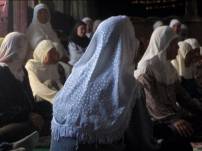 Women’s mosque: after prayer Women’s mosque: after prayer  ’A space of betwixt and between’
Let me return to
the women’s mosque with which I commenced my presentation. The new
Beijing
women’s mosque is
visited, as initially hoped for by the City authorities, by numerous individuals
and groups, Muslims and non-Muslims alike, Chinese nationals but also by many
visitors from abroad. The State project of providing a window to the outside
world of
China
’s
model of religious and cultural pluralism has been successful. It may also be
noted, however, that the mosque has as yet to receive a woman ahong. Unlike its much more humble
predecessor, which was never reopened, unlike the women’s mosques in central
China
’s Muslim communities, this beautiful, even
lavish women’s mosque lacks a female leader which is such a defining feature of
women’s tradition in
China
.
It might therefore be argued that in the interplay of transnational and local
discourses, where Arab Muslim and local conservative Islamic forces merge with the
Chinese State’s tight control over its religious affairs, women’s stake in what
was once their own institution has been diminished. We could point to a
development in which women’s local
traditions are apparently in danger of being forced out by global agendas and
pressure groups.
1. Inscription in the old
Shouliu Lane
women’s mosque (closed down in 1958)
1.
’A space of betwixt and between’
Let me return to
the women’s mosque with which I commenced my presentation. The new
Beijing
women’s mosque is
visited, as initially hoped for by the City authorities, by numerous individuals
and groups, Muslims and non-Muslims alike, Chinese nationals but also by many
visitors from abroad. The State project of providing a window to the outside
world of
China
’s
model of religious and cultural pluralism has been successful. It may also be
noted, however, that the mosque has as yet to receive a woman ahong. Unlike its much more humble
predecessor, which was never reopened, unlike the women’s mosques in central
China
’s Muslim communities, this beautiful, even
lavish women’s mosque lacks a female leader which is such a defining feature of
women’s tradition in
China
.
It might therefore be argued that in the interplay of transnational and local
discourses, where Arab Muslim and local conservative Islamic forces merge with the
Chinese State’s tight control over its religious affairs, women’s stake in what
was once their own institution has been diminished. We could point to a
development in which women’s local
traditions are apparently in danger of being forced out by global agendas and
pressure groups.
1. Inscription in the old
Shouliu Lane
women’s mosque (closed down in 1958)
1. 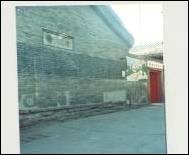 2. 2. 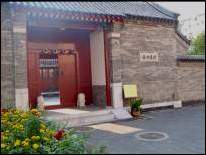 2. Inscription moved to the new women’s mosque (2007)
But there is
another, equally persuasive interpretation. Local Muslim women who live close
to the mosque, but who do not worship at the mosque, have told me that a number
of respected ahong, approached to
preside over this splendid window to the outside world, turned down such an
appointment. That they refused to have
their religious authority undermined by letting themselves be turned into
curators of cultural sites in which religiosity would be on show as a Communist
Party/State’s window to the world. This near invisible subtext of recalcitrance
is barely discernible to the outside visitor. But like the stone inscription
transplanted from a violated site of women’s worship to a site appropriated for
State-supported tourist consumption, whilst its power may be dormant, its
spirit is not extinguished. Pride in women’s own tradition means that they can
do no less than hold out, I was told by an elderly Muslim. After all, at a safe
distance from the national capital, women’s mosques continue to offer what they
have offered for hundreds of years, a home to believing women in this world and
a glimpse ‘of paradise’ in another world.
2. Inscription moved to the new women’s mosque (2007)
But there is
another, equally persuasive interpretation. Local Muslim women who live close
to the mosque, but who do not worship at the mosque, have told me that a number
of respected ahong, approached to
preside over this splendid window to the outside world, turned down such an
appointment. That they refused to have
their religious authority undermined by letting themselves be turned into
curators of cultural sites in which religiosity would be on show as a Communist
Party/State’s window to the world. This near invisible subtext of recalcitrance
is barely discernible to the outside visitor. But like the stone inscription
transplanted from a violated site of women’s worship to a site appropriated for
State-supported tourist consumption, whilst its power may be dormant, its
spirit is not extinguished. Pride in women’s own tradition means that they can
do no less than hold out, I was told by an elderly Muslim. After all, at a safe
distance from the national capital, women’s mosques continue to offer what they
have offered for hundreds of years, a home to believing women in this world and
a glimpse ‘of paradise’ in another world.
‘Working Paper For Geneva-Based
NGO Committee on Freedom of Religion or Belief and NGO Committee on the Status
Of Women.’ Civil and Political Rights (Religious Intolerance). Report of the
Special Rapporteur on Freedom of Religion or Belief in accordance with
resolution 2001/42 of Commission on Human Rights. Annexe: Study on the Freedom
of Religion or Belief and the Status of Women From the Viewpoint of Religion
and Traditions, 2003, p. 29. http://www.stop-killing.org/files/UNSR on Freedom of religion exhaustive doc
on religion and discrimination against women 2002.pdf.
The women’s mosque in Niujie opened its gates at the end of 2006; the
official approval for the construction of the mosque was not unrelated to the
Olympic Games, hosted by
China
in September 2008.
Ursula King ‘Religion and Gender: Embedded Patterns,
Interwoven Frameworks’ in A Companion to
Gender History, edited by T. A. Meade and M. Wiesner-Hanks.
Oxford
: Blackwells, 2004,
p.75.
Merry Wiesner-Hanks ‘Studying gender and religion: A
look back and a look forward’ in Kvinder,
Køn & Forskning, Nr. 1-2, 2005, p. 9. Emphasis in mine.
This approach comes within a relatively new area of anthropological
enquiry, ‘aidnography’: ethnography with a focus on the culture of development
and of development relations, see David
Mosse, 2005.
Carol
Delaney The Seed and the Soil. Gender and Cosmology in
Turkish
Village
Society.
Berkeley :
University
of
California
Press, p 20. Quoting El-Zein; emphasis is mine.
The Programme for the Development of Chinese Women
(2001-2010) includes gender equality in its overall objectives, making it a
basic State policy for the enhancement of national social progress. Six areas
are identified for priority development: women and the economy, women’s
participation in decision-making and management, women and education, women and
health, women and law, and women and the environment. (Committee on the
Elimination of Discrimination against Women. Consideration of reports submitted by States parties under
article 18 of the Convention on the Elimination of All Forms of Discrimination
against Women. Combined fifth and sixth periodic report of States Parties.
China
. 2004).
Shirley Ardener, S. (ed.) Perceiving Women.
London
:
J.M Dent & Sons, 1975.
Ong Neoliberalism as exception, p.25.
HUMAN RIGHTS COUNCIL Fourth session, Item 2 of the
provisional agenda. IMPLEMENTATION OF GENERAL ASSEMBLY RESOLUTION 60/251 OF 15
MARCH 2006 ENTITLED “HUMAN RIGHTS COUNCIL”. Report of the UN Special Rapporteur
on freedom of religion or belief, Asma Jahangir. A/HRC/4/21 26 December
2006. During the period from 1
December 2005 to 30 November 2006, a total of 64 communications were
transmitted to 34 different countries. The Special Rapporteur sent communications also to
China
(People’s
Republic of), amongst 42 sent out altogether to Asia Pacific countries.
A. Giddens The
Constitution of Society. Outline of the Theory of structuration.
Cambridge
: Polity, 1984,
p.16
Noa Nof-Steiner ‘The Multi-Faces of Islam: A
Comparative Report on Women’s Associations and Association Laws in Muslim
countries’ in International Journal of Civil Society Law Vol. V(2), 2007, p. 52.
[48] M. Dillon Xinjiang:
China
’s
Muslim Far Northwest.
New York
:
RoutledgeCurzon, 2004. D. C. Gladney, D. C. ‘Making Muslims in
China
: Education, Islamicization and
Representation’ in
China
’s National Minority Education: Culture,
Scholing and Development, edited by G.A. Postiglione.
London
: Falmer Press, 1999. R. Iredale and F.
Guo ‘Overview of Minority Migration’ in China’s
Minorities on the Move: Selected Case Studies, edited by R. Iredale, N.
Bilik and F. Guo.
New York
:
M.E. Sharpe, 2003.
.

© Maria Jaschok 2009

|
 In place of the old: the redeveloped
Hui Quarter, Beijing [6]
In place of the old: the redeveloped
Hui Quarter, Beijing [6]
 New women’s mosque (2007) Niujie (
New women’s mosque (2007) Niujie (
 Main-gate of new
Main-gate of new



 3. During prayer
3. During prayer
 Women’s mosque: after prayer
Women’s mosque: after prayer 
 2.
2. 
![]() doi:10.1016/j.ijedudev.2009.04.004 .
doi:10.1016/j.ijedudev.2009.04.004 .![]()